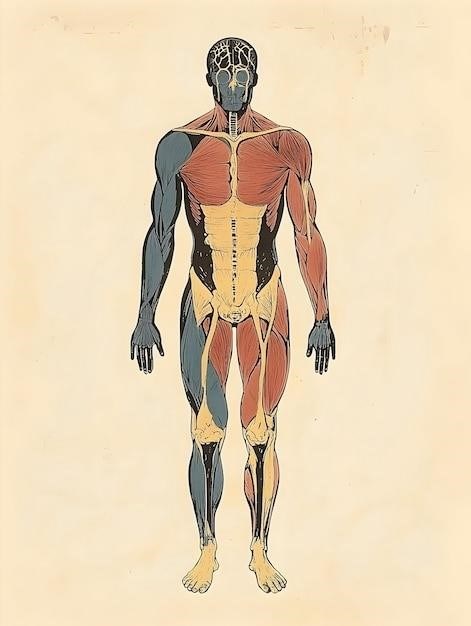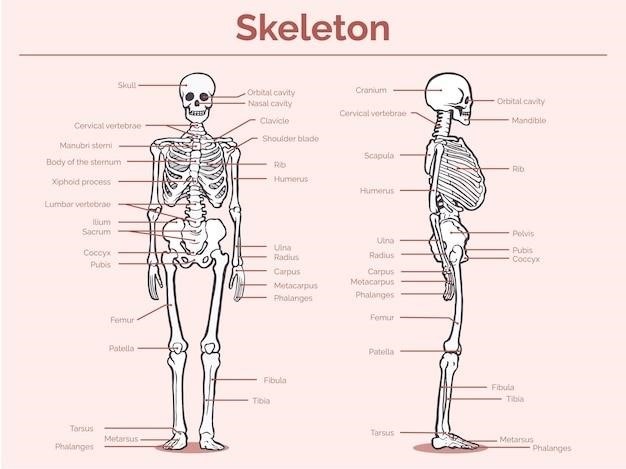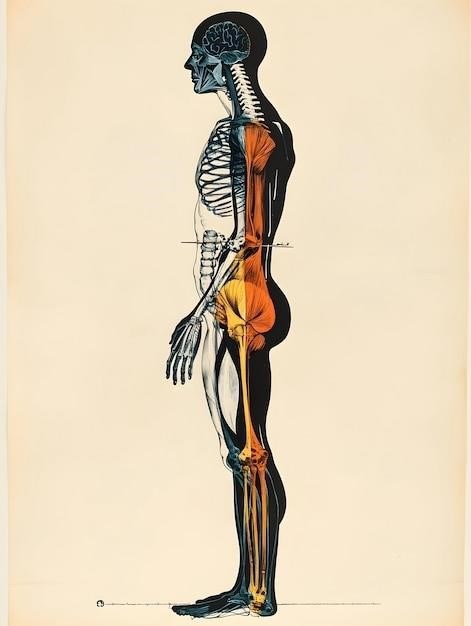Anatomy for Drawing⁚ A Comprehensive Guide
This comprehensive guide delves into the world of anatomy for drawing‚ exploring its benefits‚ essential concepts‚ learning resources‚ and practical techniques. From understanding the skeletal and muscular systems to mastering proportions and perspective‚ this guide equips artists with the knowledge and skills to create realistic and expressive figure drawings.
Introduction
Anatomy for drawing is an essential foundation for any artist seeking to create realistic and dynamic figures. Understanding the structure and function of the human body allows artists to accurately depict movement‚ pose‚ and form‚ adding depth and believability to their artwork. This guide explores the fundamental principles of anatomy for drawing‚ providing a roadmap for artists of all levels to master this crucial skill.
Benefits of Studying Anatomy for Drawing
Investing time in learning anatomy for drawing offers numerous advantages for artists. A strong grasp of anatomy empowers artists to create more accurate and believable figures‚ bringing their drawings to life. By understanding the underlying structure of the human body‚ artists can confidently depict complex poses‚ nuanced expressions‚ and subtle muscle movements. This knowledge also enhances artistic expression‚ allowing artists to push boundaries and create dynamic and captivating figures.
Essential Anatomy Concepts for Artists
To excel in figure drawing‚ artists must grasp fundamental anatomy concepts. A deep understanding of the skeletal system‚ including bone structure and articulation‚ provides a solid foundation for accurately depicting the human form. Furthermore‚ comprehending the muscular system‚ its attachments‚ and how muscles interact during movement‚ allows artists to create dynamic poses and realistic expressions. Proportions and perspective play a crucial role in creating harmonious and believable figures. Artists need to understand the proportions of the human body and how perspective affects the appearance of forms from different angles.
The Skeletal System
The skeletal system serves as the framework of the human body‚ providing support‚ protection‚ and enabling movement. Artists need to understand the structure of bones‚ their shapes‚ and how they connect at joints. Knowledge of the skeletal system helps in accurately depicting the underlying structure of the body‚ which is essential for creating believable and dynamic poses. For example‚ understanding the structure of the rib cage helps artists draw the torso with accurate proportions and curvature. Additionally‚ studying the structure of the pelvis and its articulation with the femur allows artists to depict the hips and legs with realistic movement and stability.
The Muscular System
The muscular system is responsible for movement‚ posture‚ and the shape of the body. Understanding the placement‚ origin‚ and insertion of muscles is crucial for artists. Muscles attach to bones via tendons‚ and their contraction and relaxation create movement. By studying the muscular system‚ artists can accurately depict the surface anatomy of the body‚ including the bulging of muscles during action and the subtle contours of the body’s form. For example‚ understanding the structure of the biceps and triceps muscles helps artists draw realistic arms in various poses‚ such as flexing or extending the elbow. Similarly‚ knowledge of the latissimus dorsi and trapezius muscles allows artists to depict the back with accurate muscle definition and movement.

Proportions and Perspective
Proportions and perspective are fundamental principles in drawing that influence the believability and realism of any artwork. Proportions refer to the relative sizes of different body parts‚ and understanding these ratios is essential for creating anatomically accurate figures. Perspective‚ on the other hand‚ deals with how objects appear to shrink in size and change shape as they recede into the distance. Mastering perspective allows artists to create a sense of depth and space within their drawings‚ adding realism and dynamism to the final composition. For instance‚ understanding the proportions of the head‚ torso‚ limbs‚ and hands helps artists accurately represent the human figure in various poses. Similarly‚ applying perspective principles enables artists to depict the human form from different angles‚ creating a sense of three-dimensionality and realism.
Resources for Learning Anatomy for Drawing
The journey of learning anatomy for drawing is enriched by a wealth of resources available to artists. Numerous anatomy books offer detailed explanations‚ illustrations‚ and diagrams that provide a comprehensive understanding of the human form. Online courses and tutorials provide interactive learning experiences‚ allowing artists to explore anatomy concepts through video demonstrations‚ exercises‚ and feedback. Additionally‚ reference images and anatomical charts serve as invaluable visual aids‚ offering detailed views of muscles‚ bones‚ and joints‚ providing a tangible reference for artists. These resources can be found online‚ in libraries‚ and at art supply stores‚ providing artists with a variety of options to suit their learning style and preferences. The combination of these resources fosters a well-rounded learning experience‚ enabling artists to develop a strong foundation in anatomy and confidently translate their understanding into their artwork;
Anatomy Books
Anatomy books are essential for artists seeking to understand the underlying structure of the human body. These books provide detailed illustrations‚ diagrams‚ and explanations of the skeletal‚ muscular‚ and circulatory systems‚ offering a comprehensive guide to the complexities of human anatomy. From classic texts like “Figure Drawing⁚ Design and Invention” by Michael Hampton to specialized resources like “Anatomy for the Artist⁚ A Complete Guide to Drawing the Human Body” by Jennifer Crouch‚ these books offer a wealth of knowledge for artists of all levels. They delve into the nuances of proportions‚ perspective‚ and movement‚ equipping artists with the tools to create realistic and dynamic figures. Whether used for reference or for in-depth study‚ anatomy books provide a valuable foundation for artists seeking to master the art of figure drawing.
Online Courses and Tutorials
The digital age has revolutionized the accessibility of anatomy education for artists. Online courses and tutorials offer a plethora of resources‚ from beginner-friendly introductions to advanced anatomy studies. Platforms like Skillshare‚ Udemy‚ and YouTube host a wide range of instructors‚ each with their unique approach to teaching anatomy for drawing. These courses often utilize interactive lessons‚ 3D models‚ and real-time demonstrations to provide a dynamic and engaging learning experience. Artists can explore various aspects of anatomy‚ including bone structure‚ muscle attachments‚ and the intricacies of movement. Whether seeking a structured learning program or a quick reference guide‚ online courses and tutorials offer a convenient and flexible way to enhance anatomical knowledge for drawing.
Reference Images and Anatomical Charts
Visual aids are invaluable for understanding and applying anatomical knowledge to drawing. Reference images and anatomical charts provide a visual framework for studying the human form. High-quality photographs of real bodies in various poses offer a realistic representation of muscle and bone structure. Anatomical charts‚ often found in anatomy books or online‚ provide detailed diagrams of specific body parts‚ highlighting muscle groups‚ bone connections‚ and anatomical landmarks. These visual resources allow artists to see the underlying structure beneath the skin‚ enhancing their ability to draw accurate and dynamic figures. By referencing these images alongside their anatomical studies‚ artists can gain a deeper understanding of the human form and translate that knowledge into their drawings.
Drawing Techniques for Anatomy

Mastering anatomical drawing requires a systematic approach that builds upon foundational techniques. Begin by simplifying the human form into basic shapes‚ such as spheres‚ cylinders‚ and cubes‚ to represent the head‚ torso‚ limbs‚ and joints. This approach helps establish the overall structure and proportions of the figure. Once the basic shapes are established‚ gradually add details like muscles and joints‚ using reference images and anatomical charts as guides. Focus on understanding the origin‚ insertion‚ and function of major muscle groups‚ paying attention to their shape and how they interact with the skeletal system. Practice drawing the human figure from different angles and poses to develop a comprehensive understanding of its anatomy in various positions. This approach ensures that your drawings are accurate and dynamic‚ capturing the nuances of the human form in motion.
Starting with Simple Shapes
The foundation of anatomical drawing lies in simplifying complex forms into basic geometric shapes. Begin by visualizing the human body as a collection of spheres‚ cylinders‚ and cubes‚ representing the head‚ torso‚ limbs‚ and joints. This approach provides a skeletal framework for the figure‚ establishing its overall proportions and structure. For instance‚ the head can be envisioned as a sphere‚ the torso as a cylinder‚ and the limbs as elongated cylinders. These simplified shapes serve as a starting point for building upon details and refining the anatomical accuracy of your drawings. By mastering the ability to construct the human form from basic shapes‚ you lay the groundwork for creating more realistic and dynamic figure drawings.
Adding Muscles and Joints
Once you have established the basic shapes‚ it’s time to bring the figure to life by adding muscles and joints. Focus on understanding the major muscle groups and how they attach to the skeletal system. This knowledge allows you to depict the subtle bulges and depressions that give the body its characteristic form. Pay attention to the way muscles contract and relax‚ influencing the figure’s posture and movement. Carefully study the anatomy of joints‚ such as the shoulders‚ elbows‚ wrists‚ hips‚ knees‚ and ankles. Understanding their range of motion and how they connect bones will enable you to draw realistic poses and expressions. Remember to avoid drawing muscles as rigid‚ static forms; instead‚ depict them as flowing‚ interconnected structures that contribute to the dynamic nature of the human body.
Drawing from Different Angles and Poses
To truly master anatomical drawing‚ it’s crucial to practice drawing the human figure from various angles and poses. This helps you develop a deep understanding of how the body’s form changes in perspective. Start by studying reference images or anatomical charts that depict the figure from different viewpoints‚ such as front‚ side‚ and back. Experiment with drawing the figure in dynamic poses‚ such as twisting‚ reaching‚ or bending. Pay attention to how the muscles and joints interact and how the body’s proportions shift with each movement. Remember that the body is not static; it’s a complex system of interconnected parts that move and interact in countless ways. By studying and drawing the figure from different angles‚ you’ll gain a deeper appreciation for the human form’s beauty and complexity.
Applying Anatomy Knowledge to Figure Drawing
Once you have a solid foundation in anatomical principles‚ you can start applying this knowledge to your figure drawings. Use your understanding of the skeletal system to create a believable framework for your figures‚ ensuring that their bones are positioned correctly and their joints move realistically. Next‚ layer on the muscles‚ paying attention to their origins‚ insertions‚ and actions. This will give your figures a sense of volume and definition. Don’t forget to consider the body’s proportions and perspective as you draw‚ ensuring that your figures look accurate and balanced. As you become more confident‚ experiment with different drawing techniques and styles to enhance your figures’ dynamism and expressiveness. Remember that anatomy is a tool to help you create convincing and beautiful figure drawings‚ not a rigid set of rules to follow blindly.
Creating Dynamic Poses
To bring your figures to life‚ you need to master the art of creating dynamic poses. This requires a deep understanding of how the human body moves and the limitations of its range of motion. Study reference images‚ videos‚ and anatomical charts to observe how muscles contract and relax during various actions. Experiment with different angles and perspectives to capture the energy and flow of movement. Use exaggeration and distortion strategically to enhance the dynamism of your poses‚ while still maintaining anatomical accuracy. Remember that dynamic poses often involve a sense of balance and counterbalance‚ as the body adjusts to maintain stability during movement. By understanding these principles and practicing regularly‚ you can create figures that are both visually engaging and anatomically sound.
Achieving Anatomical Accuracy
While artistic expression is paramount‚ achieving anatomical accuracy adds a level of realism and believability to your drawings. Start by understanding the basic structure of the human body‚ including the skeletal and muscular systems. Pay attention to the placement and proportions of bones‚ the insertion and origin points of muscles‚ and the way these structures interact during movement. Use anatomical reference images and charts to study specific details‚ such as the subtle curves of the spine or the intricate network of tendons and ligaments. Practice drawing from life whenever possible‚ as this provides invaluable firsthand experience with the human form. Remember that even in stylized drawings‚ a foundation of anatomical knowledge allows you to make informed artistic choices‚ creating figures that are both visually appealing and anatomically correct.
Enhancing Artistic Expression
A deep understanding of anatomy empowers artists to express themselves more effectively. By comprehending how the body moves and interacts with its environment‚ you can create dynamic poses and compelling narratives. For example‚ the subtle shifts in muscle tension during a gesture can communicate emotions and intentions. The knowledge of anatomical structure allows you to exaggerate features for dramatic effect while still maintaining a sense of realism. You can also use anatomy to create a sense of depth and dimension in your drawings. By understanding the planes and curves of the human form‚ you can create convincing shadows and highlights‚ adding depth and visual interest to your artwork. Ultimately‚ a strong foundation in anatomy allows you to go beyond simply copying what you see‚ enabling you to create original and expressive figures that tell compelling stories.
